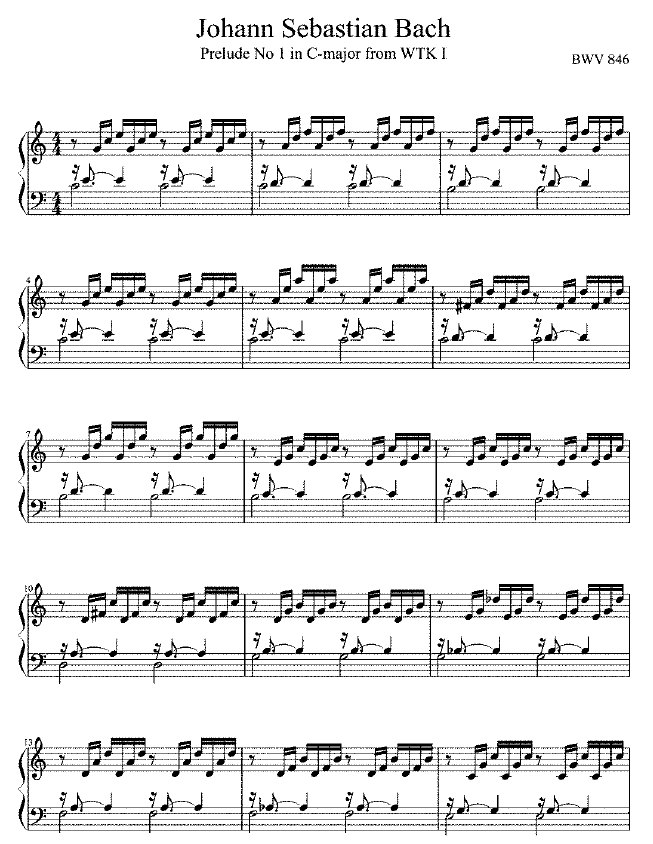Architecture in Classical Music
In this study, I compared music from Bach, Beethoven, and Chopin in three sub-categories.
- Bach’s Preludes and Chopin’s Etudes
- Beethoven’s and Chopin’s Sonatas
- Chopin’s Preludes
1. Bach’s Preludes and Chopin’s Etudes
Prelude and Fugue in C major, BWV 846 by Bach
It is the first prelude and fugue in The Well-Tempered Clavier's first book, which contains 48 preludes and fugues. The prelude is 35 bars long and consists mainly of broken chords. It continues like this with different variations on harmony and change of key. The prelude ends with a single C major chord.

Étude Op. 10, №1 in C major by Chopin
This étude, like all études by Chopin, is in ternary form (A–B–A), recapitulating the first part. The first part of the middle section introduces chromaticism in the left-hand octave melody, while the second one modulates the C major recapitulation via an extended circle of fifths.
James Huneker states that Chopin wished to begin the “exposition of his wonderful technical system” with a “skeletonized statement.”
Its harmonies resemble a chorale, and its relationship to Bach’s Prelude №1 in C major (BWV 846) from The Well-Tempered Clavier has been noted by musicologist Hugo Leichtentritt (1874–1951). British musicologist Jim Samson gives a fictional example of Chopin’s harmonies with Bach’s figuration and vice versa.

The work is to be executed at an Allegro tempo. Chopin’s metronome marking, given in the sources, is MM 176, referring to quarter notes.

This piece, waterfall, teaches stretching in the right hand. Each Chopin’s Etude is a staggering blend of difficult piano technique and highly artistic music. He cleverly invented and solved piano playing problems. The music itself is also enjoyable — extremely artistic and superbly high quality.
2. Beethoven’s sonata and Chopin’s sonata
Piano Sonata №32 in C minor, Op. 111 by Beethoven
Structure:
- The work is in two highly contrasting movements:
- 1. Maestoso — Allegro con brio ed appassionato
- 2. Arietta: Adagio molto semplice e cantabile
Like many other works by Beethoven in C minor, the first movement is stormy and impassioned — the tempo markings may be translated, respectively, as “majestic” and “brisk, with vigor and passion.”
It abounds in diminished seventh chords, as in, for instance, the first full bar of its opening introduction, which may have inspired the introduction of Chopin’s second piano sonata.
However, Chopin’s first movement is written in sonata form, while Beethoven’s first movement is a set of variations on an original theme.


The left-hand part of both pieces seems akin.
The second mimic is that both end parts of the two pieces.


The end of the étude alludes to Ludwig van Beethoven’s Piano Sonata №32, written in the same key — a piece Chopin is known to have significantly admired — compare bars 77–81 in the Étude to bars 150 – 152 in the first movement (also ending in C major) of Beethoven’s sonata.
3. Chopin’s Preludes
Chopin composed op.28 with Bach on his mind: each of the pieces is in one of the twenty-four major and minor keys, following the model of the Baroque master’s two monumental sets of preludes and fugues that make up book 1 and 2 of the Well-Tempered Clavier.
Chopin’s pieces stand as self-contained units, each conveying a specific idea or emotion. He thus imparted new meaning to a genre title that at the time was often associated with improvisatory “preluding.” In publishing the 24 preludes together as a single opus, comprising miniatures that could either be used to introduce other music or as self-standing works, Chopin challenged contemporary attitudes regarding the worth of small musical forms.
Afterthoughts
Bach’s influence was felt in the next generation of early Romantic composers, such as Beethoven, Chopin, and so forth. His fugue and counterpoint had successfully inspired numerous composers who basically followed suit. Before finishing this research project, I barely realized that imitation in classical music was a big thing. Indeed, there were many celebrated and spectacular pieces of classical music that possessed the same attribute as another piece. Thanks to Bach, he made fugue into another great peak and influenced great composers like Beethoven and Chopin. Afterward, Beethoven’s composing style also had an impact on Chopin. It was amazing to have composing means being passed down to the next generation, thus created more abundant and colorful music in the following era.
Reference
- Chopin a listener’s guide to the master of the piano
